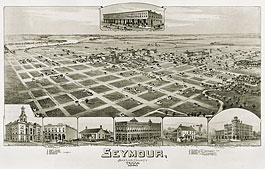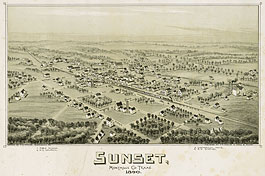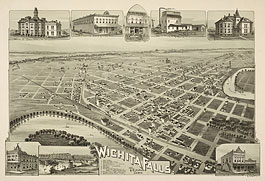Quanah in 1890 (lithograp)
The fact that Quanah was named for the Comanche chief Quanah Parker testifies to the centuries of Indian presence in the area that became Hardeman County in 1858 and explains why there was little Anglo-American settlement in the area until the 1880s. That began to change in 1884 as the Fort Worth and Denver City Railway worked on the road beyond Wichita Falls. The railroad surveyors laid out Quanah… [More]
Seymour in 1890
The Seymour that Thaddeus Fowler depicted in 1890 seemed to be a prosperous county seat with more large, stone buildings than such a small community, which was not even listed separately in the census of 1890, might justify. The substantial buildings resulted from a boom that coincided with the construction of the Wichita Valley Railroad to Seymour, located on the Brazos River, in 1890. The boom began when the… [More]
Sunset in 1890
Sunset was among the communities that benefited from the construction of the Fort Worth and Denver City Railroad through northeast Texas. Located about eight miles northwest of Alvord, Sunset dates from the 1870s, when a few settlers arrived from Denton County. When the FW&DC built its line through the county in 1882, several residents moved to the site of Sunset to be near the tracks, and the small community… [More]
Wichita Falls in 1890
The initial destination goal of the Fort Worth and Denver City Railroad as it built northwestward from Fort Worth toward the Texas Panhandle was Wichita Falls. The small community, which had attracted a scattering of settlers throughout the 1870s and established a post office in 1879, encouraged the railroad to build through the developing business district by donating land. The first construction train, with a single passenger car attached… [More]














